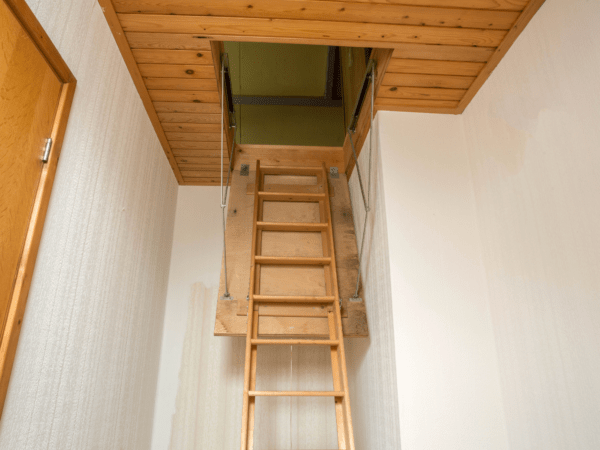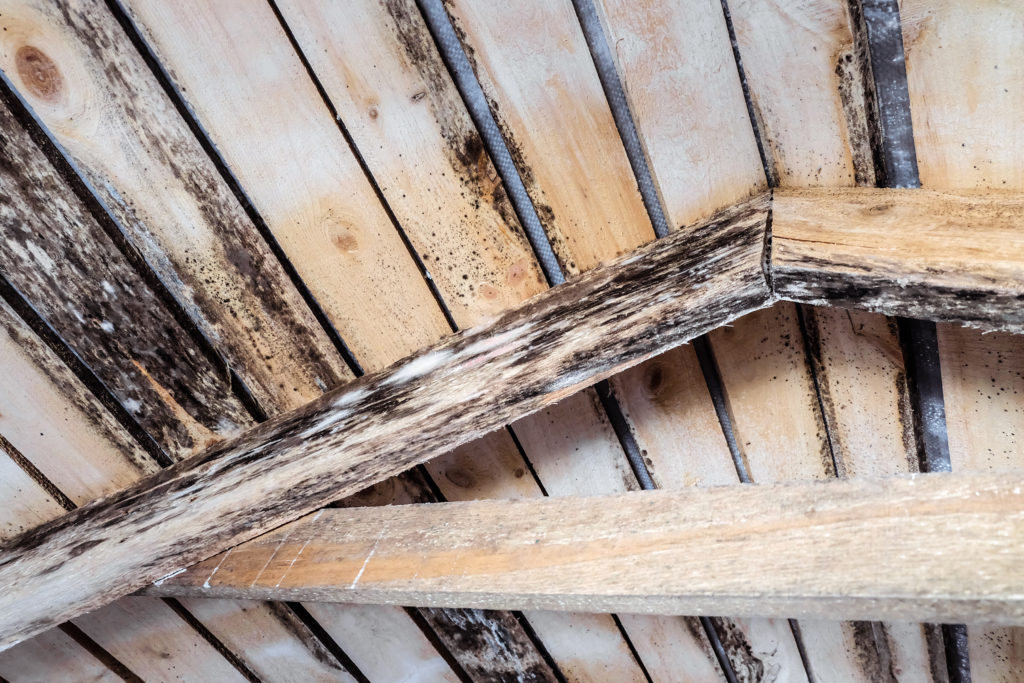Have you caught some signs that mould might be growing in your attic? Don’t ignore it – here’s what to do instead when you’ve uncovered spores in your attic!
What Causes Mould In Attics?
 While you might know that warm air rises, it does so differently in residential buildings. Warm air rises from the lower levels of the home and up through the attic, pressing upward to exit the building through a variety of openings in the upper floors. It’s called the “Stack Effect,” and mould spores can’t resist the upward airflow. It’s why mould doesn’t have to be a problem caused by shoddy construction or a leaky roof! Attics often have a passive ventilation system: outside air comes in through the soffit or eave vents at the bottom, warms up in the attic, then escapes through the vents at the top. If insulation blocks these vents, it destroys the passive ventilation system, allowing warm, humid air to stagnate and condense on the cold wood sheathing in the winter. The wet wood will subsequently grow mould, which will spread through the entire attic. If the sheathing – the layer of wood boards affixed to the joists and trusses – has visible black or white stains, your home likely has a ventilation issue that you must address. The other step is mould remediation, and you do this as soon as you can.
While you might know that warm air rises, it does so differently in residential buildings. Warm air rises from the lower levels of the home and up through the attic, pressing upward to exit the building through a variety of openings in the upper floors. It’s called the “Stack Effect,” and mould spores can’t resist the upward airflow. It’s why mould doesn’t have to be a problem caused by shoddy construction or a leaky roof! Attics often have a passive ventilation system: outside air comes in through the soffit or eave vents at the bottom, warms up in the attic, then escapes through the vents at the top. If insulation blocks these vents, it destroys the passive ventilation system, allowing warm, humid air to stagnate and condense on the cold wood sheathing in the winter. The wet wood will subsequently grow mould, which will spread through the entire attic. If the sheathing – the layer of wood boards affixed to the joists and trusses – has visible black or white stains, your home likely has a ventilation issue that you must address. The other step is mould remediation, and you do this as soon as you can.
Clean The Mould
When there’s mould in your attic, your first call should be to proper remediation professionals. Mould remediation must remove the spores to prevent human exposure and damage to building materials and furnishings. We must remove all visible staining and the root “hyphae” of the mould – the tangly network of growths that help mould spread. Even dormant mould can be an allergen, so encapsulating the mould or painting over stains is not a proper remediation method. Protective barriers or anti-microbial paints have a limited shelf life and fail over time when homeowners don’t address the source of the moisture. In fact, you should not handle attic mould yourself. Attics are small, hot, confined spaces, and respiration can be difficult in this part of the home. The issue is even more complicated so when the space is filled with spores! Proper remediation also requires special tools and procedures like negative air setup, containment, temporary flooring, and more. These take time and experience to learn and perform properly, meaning you should leave any mould removal to the professionals.
Why Should I Take Mould In My Attic Seriously?
 Once we have removed the mould, you must tackle the cause. You might not think this is a crucial step, especially if you’ve heard that attic mould does not affect indoor air quality. It is true that mould spores from this part of the home rarely show up on indoor air quality tests. So why handle it ASAP? When left unchecked, attic mould growth can lead to structural deterioration of attic sheathing and roof structural elements. Your home has an underlying moisture problem that you must resolve, as mould needs moisture to grow and spread. The longer one waits to address this issue, the more expensive repairs and remediation become. Mould in attics is also a sign to most would-be buyers and homeowners that the moisture issue will be a recurring problem that will come up in every home inspection. Knowing the signs of attic mould, getting rid of it, and solving the root cause can save you a lot of time and effort while trying to sell your home!
Once we have removed the mould, you must tackle the cause. You might not think this is a crucial step, especially if you’ve heard that attic mould does not affect indoor air quality. It is true that mould spores from this part of the home rarely show up on indoor air quality tests. So why handle it ASAP? When left unchecked, attic mould growth can lead to structural deterioration of attic sheathing and roof structural elements. Your home has an underlying moisture problem that you must resolve, as mould needs moisture to grow and spread. The longer one waits to address this issue, the more expensive repairs and remediation become. Mould in attics is also a sign to most would-be buyers and homeowners that the moisture issue will be a recurring problem that will come up in every home inspection. Knowing the signs of attic mould, getting rid of it, and solving the root cause can save you a lot of time and effort while trying to sell your home!

